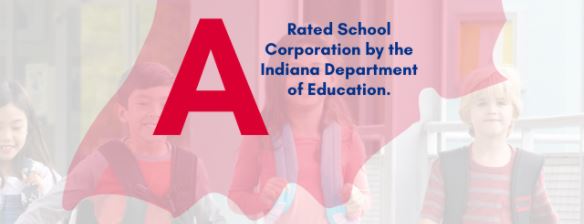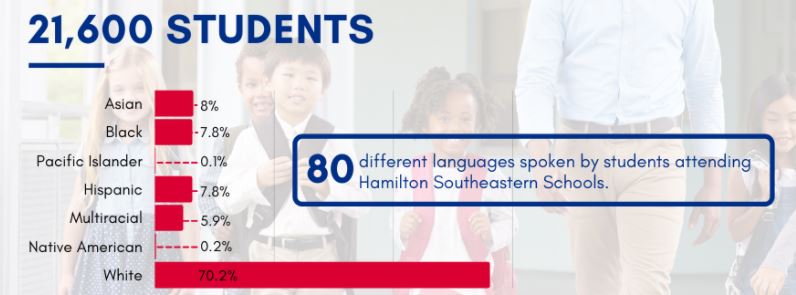
On August 26th, Hamilton Southeastern Schools had their first meeting of the new HSEngaged program. The meeting occurred at the HSE Central Office on Cumberland. The agenda for the first meeting was to overview the program, introduce the participants, get an update from the superintendent, and then cover the new teacher-in-residence programs.
The HSEngage program is new program that extends over many months with the focus of giving participants a deeper understanding of “facets of the district, including business management, academic programs, student services, operations and more.” While a large number of people applied to be in the program, there were a limited number of slots for the program. If the program is successful, then it will be offered again to a new group. You can find more information about the program at https://www.hseschools.org/happenings/hsengaged.
In the interest of sharing, the following are my notes and comments from the meeting. Note that my notes are far from perfect and are rough. Others attending the meeting are likely to post their notes as well.
Comments from Superintendent Dr. Stokes
The main meeting started with Dr. Stokes talking. Dr. Stokes talked about how she fell in love with education.
“Our children thrive in our schools when they understand their value, know they are loved, and supported, and are inspired to excel in all facets of their lives.”
“Transforming learning and live outcomes for students through education, equity and academic excellence required an all-hands-on-deck approach by ALL of us”
– Dr. Yvonne Stokes, Superintendent
“Students are pretty much the same. They have the same needs. They want to be loved, supported ….”
Dr. Stokes presented the 4 Es of preparing kids for the future. She has mentioned these before:
- Enroll in a University and be successful. Teach them to make self-connections and advocate for themselves.
- Enlist – If our kids so choose, we want to make sure we support kids in this choice
- Employment – Some kids will want to go straight into the workforce. We want them to be able to do this without needing to struggle.
- Entrepreneurship –
Many of our students will likely do more than one of these “Es”.
Dr. Stokes also commented on the district having over 2,500 staff members. We need to be aware that with that many employees, clearly not everyone is going to think alike. She also presented information on some of the data and distinctions about the district:

- HSE is recognized by the Indiana Department of Education (IDoE) as an A rated school. To be an “A” rated school requires a number of items. This includes things like attendance, test scores, and more. To keep this ranking, takes kids being in school. If you don’t have 95% attendance or higher, 95% participation in testing, then you can lose this ranking.

- HSE has a 97.6% graduation rate. Even though this is high, Dr. Stokes commented that we can always strive to do better. The state graduation level is 87%.
- Gold Star Schools. We have 21 Gold Star schools awarded by IDoE. This requires showing initiative to raise student achievement.
- Title III Distinguished School District shows that we have an inclusive school for those that speak languages other than English. The students within HSE speak 80 different languages.
- Green Ribbon School Award – A school that leverages the environment that promotes students, creativity, and inquiry.
- 5 Blue Ribbon Schools – This shows that you are closing the achievement gap among student subgroups. These sub groups are things like socio-economic status, race, “English Language Learners”, and more. HSE follows the same subgroups that the federal government uses.
- 16 Four Star Schools – Must have received an “A” by the state. Also must have tested 95% of the students on English, Language, Arts. They must have a combined 95% pass rate on the iLearn testing. And more… Testers at grade level are at top 25%.

Dr. Stokes talked about her 100 Day plan. Her plan was not static. One of her elements was to get out into the community and listen. She stated she is a data driven person. She listens, but it might be that the data you present isn’t the same as the data of the other 21,000+ people. She is on a continuous listening tour. She commented that listening is different than responding to ‘demands’ that might be given.
The District Creates Yearly Goals.
District goals are not online yet. Dr. Stokes commented that It isn’t enough to simply state the goals; Goals have to have plans behind them. School Improvement Plans are due October 8th. These should have indicators that show where students are expected to be impacted. For example, iLearn is just one indicator they are using. Schools in the district will set targets. Dr. Stokes will be a confidence rating/interval on these goals set by the schools.
Each year, the School Board approves three goals
Academic Goal: All students will demonstrate growth in academic achievement and proficiency.
Operational Goal: All divisions of HSE Operations will evidence efforts support for student academic success. (an example is right sizing web site)
Communication Goal: – Access to HSE information by internal and external stakeholders, and those exploring HSE will be assessed and redesigned, if necessary, for greater ease and consistency.
Dr. Stokes is excited about being in the district. She asks that people look at the “Why” behind decisions. There is a joke among superintendents that they are only as good as the last decision they make….
Teacher In Resident Programs
After Dr. Stokes presented, the meeting turned to focus on the Teacher in Residence programs. These are programs where teaching occurs outside of our schools. Specifically, HSE has a teacher in residence at Conner Prairie, the Fishers AgriPark, and at Hub & Spoke. These programs happen for fourth graders (at Conner Prairie), second graders (Farm 2 Table at the AgriPark) , fifth graders (Maker 5 at Hub & Spoke).
One of the comments regarding the role of the Teacher in Residence Programs:
“Our Daily Vision: What experience can I create for students that they can’t get anywhere else?”
It was stated that HSE is the only district doing the kinds of experiences being presented via these programs. This is education outside of a classroom setting that still focus on providing education on Indiana Standards. Students come to the programs at the locations mentioned. This happens throughout the year regardless of weather.
For example, the 1600 fourth graders within HSE will go to Conner Prairie 4 times this year. The district’s second graders will go the AgriPark 3 times. The fifth graders will go to the AgriPark 3 or 4 times this year.
At these locations, the students will do standards-based education in a hands-on way. For example, at Conner Prairie, 4th graders will analyze the flight pattern of an arrow they shoot and learn about buoyancy by using a small boat on the White River. These programs work to make learning enjoyable.
At the Hub & Spoke program, they teach kids that if they have a problem, they can think up and create a solution. The kids work to collect data and problem solve. This will include doing research and will use mindset, engineering, and other skills.
The programs can be summarized as “Bringing learning to life.”
These three programs are all happening this year. The second-grade program is launching after Labor Day. The fifth-grade program is launching as well.
It is worth noting that in addition to the Residence programs in There is also a first-grade program, “Nature first” that happens at Ritchey Woods?
Q&A at HSEngage
How does the district rationalize the cost of the teachers in residence versus just standard field trips?
>> There is more consistency in the program being taught across teachers. With these programs, there is the ability to provide a structure for teachers to use that allows them to prepare kids before the program and then use learning from the program in the classroom after the program.
As an example of the value of these programs, “force in motion”, which is part of the Conner Prairie program was mentioned. “Force in motion” might have been a packet when you went to school many years ago. Teacher might have done a demonstration at the front of the room. Now the teachers have a different experience, and it is much more hands-on with these Teacher in Resident experiences. This is accomplished with more “co-teaching” between the classroom teacher and teachers in resident.
Can the school scale out the programs to the community?
This is part of what the partnership with the City of Fishers helps accomplish. The hope is that if the programs are successful, that the programs will be expanded.
The person asking this question used an example of the AgriPark. People go there and are not sure what to do. If there was a guide, that could help them. This seems like something that could be an extension of the school’s program since there is already a program being presented.
Dr. Stokes commented that what is being done with the Teacher in resident programs has to contribute to the state teaching standards and teaching that are expected to happen in our schools. These programs are not done “just for fun”.
It was also stated that there are teachers at each school that represent the programs.
Other comments regarding the Teacher in Resident programs were that these are “study trips” more so than “field trips” Additionally, it was stated that before age 8, diverse experiences can contribute to a child’s vocabulary. The district has a limited budget, so there is only so much that a school district can do, but these programs help provide diverse experiences for the second, fourth, and fifth graders.
# # #
The HSEngage attendees also introduced themselves briefly to each other and played a game of Kahoots as teams. Kahoots is a trivia program that I know my kids have used many times in their classrooms. Many of the trivia questions revolved around statistics about the district. Many of those stats can be found in the information presented at https://www.hseschools.org/services/human-resources. (The images on this post are from that data as well.
